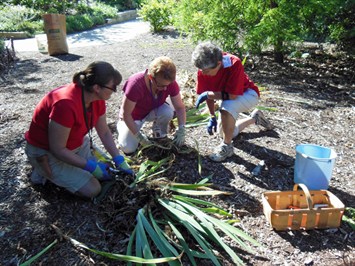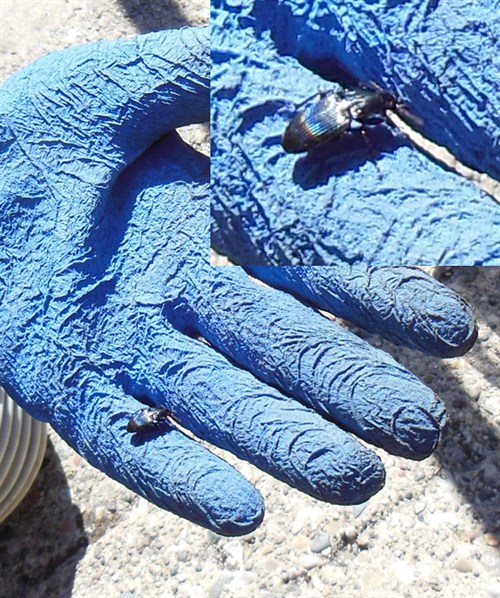Lately in our own garden and those we tend, we've been:
Appreciating
annual flowers Marveling: Beetles
Dividing
irises
Nibbling the veg
Cutting down
peonies
Learning by doing
This page is Sponsored by:
Appreciating annual flowers
A late summer garden can become wan, tired and picked over. When
others say their gardens have come to that yet we're still enjoying
ours, it's because we kept the annuals well watered during summer
drought, deadheaded and also clipped back whenever they got
a bit rangy. How full, fresh and colorful they are now.
At our Detroit Zoo Adopt-a-Garden beds, that's just in time for
the busy season of back-to-school field trips. 
Dividing irises
Hoo boy, are we glad we tied some string around the clumps of
bearded iris to help us keep track of which color flowers are where
in the bed. Otherwise we would never know which were which now. And
what smart cookies we were to use a photo to remind us where we
intended to plant them in the gardens at the Detroit Zoo.
Below, right: In May this year we decided that at
iris-dividing time we would put white irises in the left foreground
where Judy Storrs is standing, yellow on the right at little Lily
Koen's spot, and peach in the middle by Michele Armstrong.
Too bad we forgot to include a color tag in each segment of the
bed. So although we could be sure segment A plants are all one
color, segment B another, we didn't know if A plants were yellow or
white, or peach. Also, we took the photo of Judy, Michele and Lily
to remind us where we wanted to plant our iris divisions, but
forgot to bring it with us on iris dividing day.
Ah well, the best laid plans gang oft aglee! So we kept plants
from each segment segregated as we divided, then simply planted a
three color cluster at several sunny places in the garden.
Maybe we'll sort it out next May!
Below, left: Master Gardener Adopt-a-Garden volunteers Kari
Grady and Debi Slentz guide volunteer Karen Thompson through her
first iris division. "Throw out any roots that have soft spots..."
(Close up on iris divisions and handling soft rot in Iris
allowed in the kitchen.)


Above, right: Adopt-a-Garden volunteer Phil Gigliotti
collects a few divisions of the iris Grady, Slentz and Thompson are
working on and is advised by Grady, "Pick up some from each of
those other two piles so you have all three colors, but don't ask
us which color is which!"

Cutting down peonies
...that have discolored foliage. We clip them all the way to the
ground, and rejoice if the stem we cut is not discolored inside. A
clean, white core means we removed it before it transmitted its
fungal infection to the root.

For more on peony problems:
• See What's
Coming Up 51. (Page 3, above.)
• Also check What's Coming Up 111 (page 14, left) from
your own files of back issues or
• Use our CD Potting Up
Perennials, or
• Consider helping us post that issue sooner.
Sponsor
us with a request for more peony info.
Below: Do we wonder if those peonies we cut now will survive
early cut-back? No worries! If we need assurance, we just clear
some soil from the base of the stems, see the buds set there and
know we're already "on" for next year.
See the decayed spot indicated
by the orange arrow (above)? That's where an infected stem base
once attached. You'll have more flowers and better looking
foliage if you protect those underground buds from infection as
they push past such spots in spring (below). Do it by removing
suspect stems now, reducing the fungus' presence.
Marveling at Nature
It's a lifelong discovery.
This skittery-fast blue-black ground beetle is one of the
good guys we encounter, a predator of other insects. When it flees
as we dig in the garden or overturn rocks, we let it be.
To read more about ground beetles and see a picture of its
larval stage (equally beneficial, and fearsome to behold), check this Iowa State University bulletin. Scroll
down past the descriptions of destructive cutworms and white grubs
to reach the beetles.
Nibbling
through the veg
Well, perhaps chowing down is the better description. We try,
but often fail to keep our hands off our clients' vegetables as we
work. Nothing better than broccoli just snapped from the plant, a
cucumber still warm from the sun...
Loving to learn by doing
Many of those who volunteer with us at the Detroit Zoo first
came to learn at a Garden by Janet & Steven
session. If you prefer hands-on learning, too, come join us at the
zoo or your choice of other locations. Watch and/or give these
activities you see here a try. Click for more about what goes on
and how to get involved in a Garden by Janet &
Steven session.
Why do we offer free workshops? To share what we know. Also,
there are perks in it for us, like many hands making light work if
people choose to help drag and bag prunings. Here, Carolyn Reidel,
Jim Ranieri, Judy Fritzsche and Nancy Ranieri manned the
over-the-fence end of the branch brigade when we pruned at Ray
Wiegand's Nursery's fabulous display gardens.
.

You can Sponsor us,
too. Please do!
To read other Sponsor-recommended
pages...